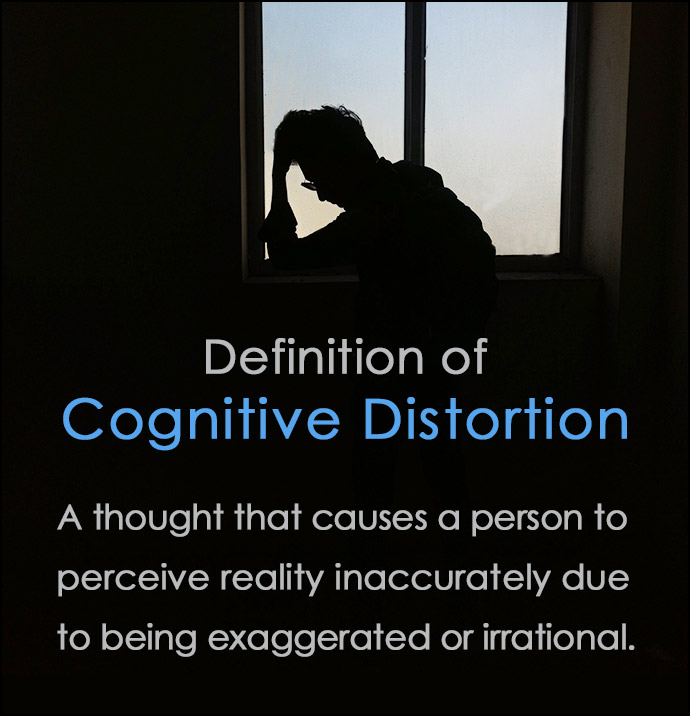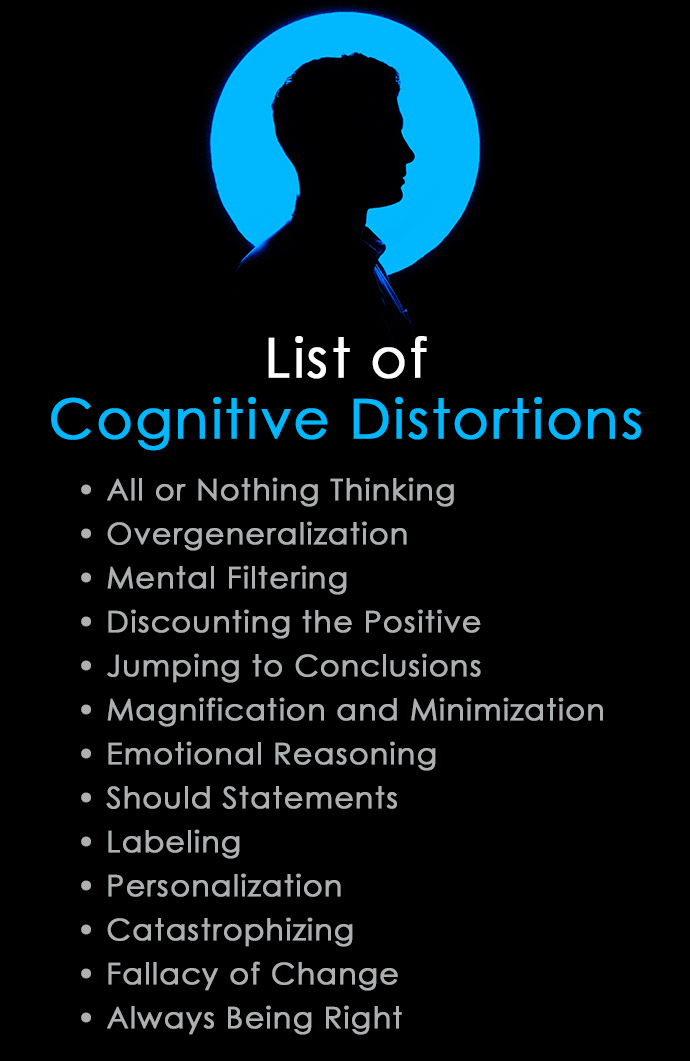
Cognitive distortions are flawed thinking patterns associated with mental health issues like anxiety, depression, and addiction.
They are a form of automatic negative thoughts that have an impact on emotions, behaviors, and the way we perceive ourselves and others.
To grasp how they affect the way we think and our mental health, it’s helpful to explore a list of cognitive distortions.
What are Cognitive Distortions?
The term, cognitive distortion is defined as, “a thought that causes a person to perceive reality inaccurately due to being exaggerated or irrational,” according to Wikipedia.
Cognitive distortions are the result of negative or faulty thinking that may lead to stress, anxiety, and different forms of depression.
This type of thinking usually occurs automatically and unconsciously and causes a person to falsely believe situations to be negative, even though there is no evidence to merit that belief.
Distorted negative thought patterns shape the way we think and behave in response to stressful situations.

A Typical List of Cognitive Distortions Includes:
- All or Nothing Thinking
- Overgeneralization
- Mental Filtering
- Discounting the Positive
- Jumping to Conclusions
- Magnification and Minimization
- Emotional Reasoning
- Should Statements
- Labeling
- Personalization
- Catastrophizing
- Fallacy of Change
- Always Being Right
The Impact of Cognitive Distortions on Mental Health
Cognitive distortions negatively impact many types of mental health disorders by contributing to the development of anxiety, depression, and PTSD symptoms.
They also amplify the negative symptoms of existing mental health conditions.
If not properly managed, cognitive distortions can:
- Increase stress levels
- Decrease self-esteem
- Strain relationships
- Encourage negative thought patterns
- Undermine emotional wellbeing
- Reduce motivation
- Reinforce unhealthy behaviors like substance use
List of Cognitive Distortions Examples
1. All or Nothing Thinking
“All or Nothing Thinking” is sometimes referred as “black and white thinking” because a person views a situation or circumstance in absolute terms. It is either good or bad, or all or nothing, with no middle ground in between.
Example: I am either perfect or I am a complete failure.
2. Overgeneralization
“Overgeneralization” occurs when an individual makes a sweeping assumption or a broad conclusion from a single event without considering any other alternatives.
Example: I failed my driving test so I will never get my license and be able to drive a car.
3. Mental Filtering
“Mental Filtering” is a cognitive distortion that causes a person to only see the negative aspects of a problem while filtering out the positives.
Example: An employee receives an excellent performance review at work with many positive attributes, and one item to improve in the future. The employee only recognizes the item to improve as a negative and ignores all the positive aspects of the reviews.
4. Discounting the Positive
“Discounting the Positive” is a common way for people to reject or dismiss a positive experience as lucky, insignificant, or unimportant.
Example: I only received employee of the month at work because everyone else has already won it, so it was my turn.
5. Jumping to Conclusions
“Jumping to Conclusions” is caused by making a quick decision or assuming the worst without any facts or evidence.
Example: My husband always works late at the office, so he must be having an affair with a co-worker.
6. Magnification and Minimization
When something is “Magnified,” it is exaggerated or amplified, and when it is “Minimized” it is down-played or considered insignificant.
Magnification Example: My date had two glasses of wine at dinner, and I think she might have a drinking problem.
Minimization Example: My date had four glasses of wine at dinner but she stayed in control, so she probably doesn’t have a drinking problem.
7. Emotional Reasoning
“Emotional Reasoning” is the result of thinking something is true because it “feels” true from an emotional standpoint and is not based on factual evidence.
Example: I have a good feeling that the Rams will win the Super Bowl this year, so I’m going to bet heavily on them.
8. Should Statements
“Should Statements” include the words “should” or “must” and are often statements meant to motivate, but they usually have unintended negative undertones as a way of self-criticizing oneself.
Example: I should not have eaten that cake after dinner, and I must lose weight.
9. Labeling
“Labeling” is a cognitive distortion of attaching or assigning a label to oneself or another person.
Example: I always feel depressed so I must be worthless.
Example: He got in a car accident so he must be a reckless person.

10. Personalization
“Personalization” involves assigning yourself too much blame or responsibility for events or circumstances that are beyond your control.
Example: I worked too many hours when my son was younger and that is why he is using drugs and alcohol as a teenager.
11. Catastrophizing
“Catastrophizing” arises from anticipating the worst possible scenario to happen in every situation.
Example: I’ve had stomach cramps for the past three weeks, so I probably have cancer.
12. Fallacy of Change
“Fallacy of Change” is a distorted view that other people should change their ways to suit your needs.
Example: If my husband really loved me, he would spend more time doing the things I enjoy.
13. Always Being Right
“Always Being Right” is difficult to overcome for people who have strong beliefs about certain topics. Even when faced with overwhelming facts and evidence to the contrary, they still fail to change their beliefs or admit they were wrong.
Example: Research shows that smoking cigarettes causes cancer and other health conditions, yet many people believe since they have been smoking for years without any problems the research must be wrong and they refuse to quit.
This list of cognitive distortions examples illustrates negative thought patterns that can shape our emotions and behaviors.
Being able to recognize faulty thinking is necessary for challenging unhealthy thoughts and reframing them to be more positive.
Replacing distorted thinking with healthier thought patterns reduces stress and anxiety and improves mental health, mood, and overall wellbeing.
FAQs About Cognitive Distortions
What causes cognitive distortions?
Cognitive distortions are inaccurate or unrealistic thoughts that can lead to negative emotions and mental health issues.
Key causes of cognitive distortions can include:
- Adverse life experiences
- Mental health conditions (depression, PTSD, anxiety disorders)
- Coping mechanisms used to deal with stress
- Biological factors (overactive amygdala)
- Being unaware negative thought patterns
What are the most common cognitive distortions people experience?
The most common examples of cognitive distortions include:
- All-or-Nothing Thinking
- Overgeneralization
- Mental Filter
- Disqualifying the Positive
- Jumping to Conclusions
- Catastrophizing
- Emotional Reasoning
- Should Statements
- Labeling
- Personalization
What are typical triggers for cognitive distortions?
- High levels of stress or anxiety
- Depressive episodes
- Trauma or adverse life experiences
- Low self-esteem
- Perfectionism
- Social situations
- Failure or perceived failure of personal goals
- Criticism or negative feedback
- Major life changes
- Relationship problems
- Comparing oneself to others
How can I identify my own cognitive distortions?
Here are some ways to identify cognitive distortions:
1. Write your thoughts in a journal each day and pay special attention to the negative ones. Review the journal once or twice a week and look for negative thought patterns.
2. Become familiar with the list of cognitive distortions so you can identify them when they occur.
3. When you have a negative thought, ask yourself: “Is it based on facts or feelings, are you exaggerating the situation, are you jumping to conclusions, and are you ignoring positives and only focusing on the negatives?”
4. Be aware of extreme words like “should, must, always, never, everyone, or nobody” that often indicate some form of distorted thinking.
5. Be conscious of overgeneralizing.
6. Pay attention to negative self-talk and self-criticism.
7. Ask friends or family if your thoughts are accurate or distorted.
How can cognitive distortions be managed?
1. Cognitive Behavioral Therapy (CBT) is an excellent tool for identifying and changing cognitive distortions and negative behaviors. Rational Emotive Behavior Therapy, simply known as REBT Therapy, also targets rational and irrational thoughts and beliefs.
2. Identify and label cognitive distortions when you notice them.
3. Challenge negative thoughts when they occur and look for evidence to contradict them instead of believing them at face value.
4. Practice mindfulness, deep breathing techniques, and grounding exercises.
5. Reframe or replace negative thoughts with positive, realistic ones.
6. Cultivate self-care and self-compassion and speak to yourself in a kind and healthy way.
Learning how to manage cognitive distortions takes time and effort.
Over time, creating an awareness of negative thinking, and challenging or reframing distorted thoughts can lead to better mood and emotional health.
Related Posts
- 12 Common Household Products and Foods that can Cause False Positive Drug Tests
Did you know there are commonly-found household products and foods that can cause false positive…
